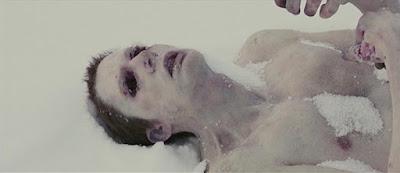Format: Streaming video from Amazon Prime on Fire!

For the last few years, I’ve been on my local environmental commission, doing what little I can to at least try to make my farm town more environmentally aware (I had to leave in February for personal reasons). It’s always an uphill battle, especially when monetary issues are placed above environmental ones—and with a few massive corporations adding warehouses and facilities in the area, this has happened a lot lately. Personal issues are forcing me to step back for a time, but the concern is still there. We’re going to start seeing this more and more in our media—the environmental concern I mean. The future of horror is climate horror, and films like The Last Winter are the start of this. The fact that this is almost 20 years old and things have only gotten worse is concerning.
There are a lot of places where a horror movie focused on climate catastrophe could take place. Putting this in an oil drilling camp in Alaska is one of those obvious places. Our oil drilling team from a fictional company called North is looking to drill in the Arctic National Wildlife Refuge and needs to build ice roads to bring in the equipment. The problem is that the permafrost is melting and they don’t have enough of a sustained freeze to get the roads built. The camp is facing a great deal of stress because of this. The leader of the expedition, Ed Pollack (Ron Perlman) is obviously pro-drilling, and butts heads with the required environmentalist, James Hoffman (James LeGros). Further complicating things are that Ed’s previous sexual partner Abby Sellers (Connie Britton) has taken up with James during Ed’s absence from the camp.
Things very slowly start going south at the camp. Maxwell (Zach Gilford), who is the son of Ed’s boss, convinced to spend time at the camp as a way to learn the business and connect to nature, starts to slowly become convinced that there is something “out there.” He starts behaving strangely, disappearing onto the tundra and reappearing hours later. He stops eating and starts appearing more and more disturbed. Second environmentalist Elliot (Jamie Harrold) is similarly convinced that something is going wrong and that nature is starting to fight back; his increasingly frequent nosebleeds are cause for concern. Maxwell vanishes and is discovered out by an old well, naked and frozen in the snow, his eyes gone. The video camera he took with him shows him being attacked by something, and in defense of his position, Ed burns the tape. Naturally this does not go well with everything else, and the decline of morale, peace, and most especially sanity at the camp starts to spiral.
While there are plenty of horror films that are just about being scary (the average slasher, for instance), horror movies that actually have something to say are going to be about the fears of the generation in which the movie was made. Politically, the left tends to make movies about zombies, since they see the right as mindless followers unable to make a decision on their own. The right makes movies about vampires, since they see the left as decadent wastrels feeding on the lifeblood of others. But horror movies do more than just reflect political ideas; they show what societies are scared of. We’ll see a lot of horror that is about isolation in the years ahead as a reaction to 2020 and COVID. And we’re going to start seeing more and more movies about the climate. That will be reflected in blockbusters like 2012 and the like, but we’re going to see more and more films like The Last Winter that put us all in the path of a rampaging, pitiless planet.
The most obvious film to connect this to is The Thing, mainly because of the setting but also because what happens to the people in the film causes a great deal of paranoia and isolation in the people involved. A much more interesting connection is to Larry Fessenden’s Wendigo, a film that has many similar themes. In fact, the wendigo is invoked in this film as a sort of avenging spirit of the land, which certainly seems appropriate.
The biggest failure of the film is some of the effects. This comes from a pair of important factors. The first is that The Last Winter has a budget of about $7 million, and in 2006, that’s not going to get you great special effects of the sort needed here—the sort that creates giant ghost creatures out on the Alaskan tundra. The other factor is that this was made in 2006, and special effects weren’t nearly as good as they are now, at least in terms of CGI.
I don’t say this often, but The Last Winter is the sort of film that could stand a remake. The message is there, the genuine fear is there, and with a better budget, this has a natural audience for what it is selling.
Why to watch The Last Winter: The future of horror is climate horror.
Why not to watch: If you’re a “Drill baby drill” person, this movie will feel like left-wing wankery.
